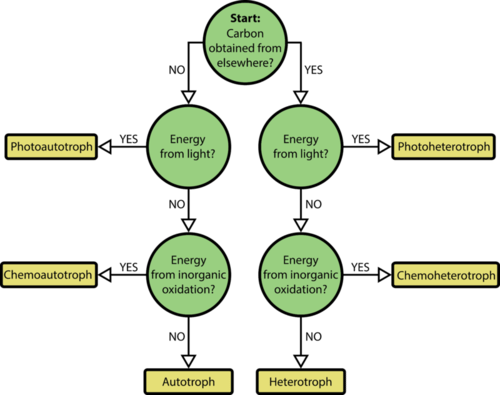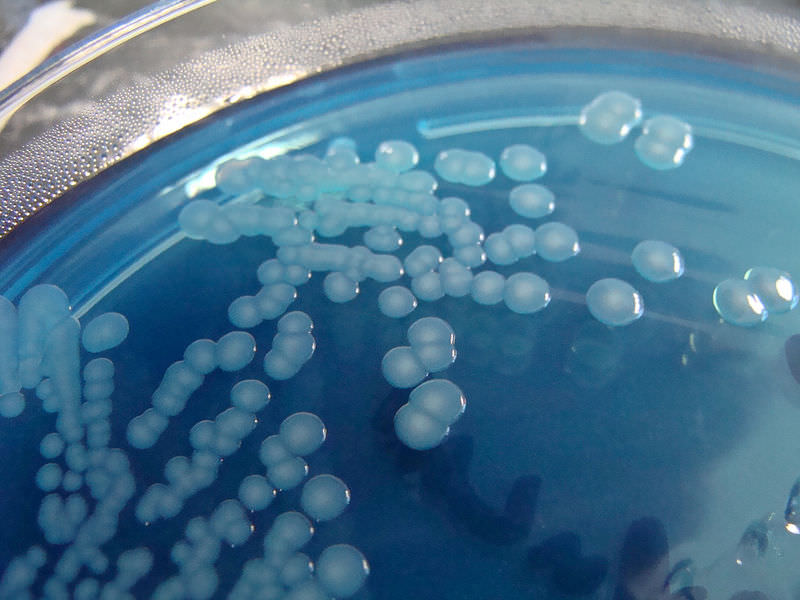7.12: Bacteria Nutrition
- Page ID
- 1462
\( \newcommand{\vecs}[1]{\overset { \scriptstyle \rightharpoonup} {\mathbf{#1}} } \)
\( \newcommand{\vecd}[1]{\overset{-\!-\!\rightharpoonup}{\vphantom{a}\smash {#1}}} \)
\( \newcommand{\dsum}{\displaystyle\sum\limits} \)
\( \newcommand{\dint}{\displaystyle\int\limits} \)
\( \newcommand{\dlim}{\displaystyle\lim\limits} \)
\( \newcommand{\id}{\mathrm{id}}\) \( \newcommand{\Span}{\mathrm{span}}\)
( \newcommand{\kernel}{\mathrm{null}\,}\) \( \newcommand{\range}{\mathrm{range}\,}\)
\( \newcommand{\RealPart}{\mathrm{Re}}\) \( \newcommand{\ImaginaryPart}{\mathrm{Im}}\)
\( \newcommand{\Argument}{\mathrm{Arg}}\) \( \newcommand{\norm}[1]{\| #1 \|}\)
\( \newcommand{\inner}[2]{\langle #1, #2 \rangle}\)
\( \newcommand{\Span}{\mathrm{span}}\)
\( \newcommand{\id}{\mathrm{id}}\)
\( \newcommand{\Span}{\mathrm{span}}\)
\( \newcommand{\kernel}{\mathrm{null}\,}\)
\( \newcommand{\range}{\mathrm{range}\,}\)
\( \newcommand{\RealPart}{\mathrm{Re}}\)
\( \newcommand{\ImaginaryPart}{\mathrm{Im}}\)
\( \newcommand{\Argument}{\mathrm{Arg}}\)
\( \newcommand{\norm}[1]{\| #1 \|}\)
\( \newcommand{\inner}[2]{\langle #1, #2 \rangle}\)
\( \newcommand{\Span}{\mathrm{span}}\) \( \newcommand{\AA}{\unicode[.8,0]{x212B}}\)
\( \newcommand{\vectorA}[1]{\vec{#1}} % arrow\)
\( \newcommand{\vectorAt}[1]{\vec{\text{#1}}} % arrow\)
\( \newcommand{\vectorB}[1]{\overset { \scriptstyle \rightharpoonup} {\mathbf{#1}} } \)
\( \newcommand{\vectorC}[1]{\textbf{#1}} \)
\( \newcommand{\vectorD}[1]{\overrightarrow{#1}} \)
\( \newcommand{\vectorDt}[1]{\overrightarrow{\text{#1}}} \)
\( \newcommand{\vectE}[1]{\overset{-\!-\!\rightharpoonup}{\vphantom{a}\smash{\mathbf {#1}}}} \)
\( \newcommand{\vecs}[1]{\overset { \scriptstyle \rightharpoonup} {\mathbf{#1}} } \)
\( \newcommand{\vecd}[1]{\overset{-\!-\!\rightharpoonup}{\vphantom{a}\smash {#1}}} \)
\(\newcommand{\avec}{\mathbf a}\) \(\newcommand{\bvec}{\mathbf b}\) \(\newcommand{\cvec}{\mathbf c}\) \(\newcommand{\dvec}{\mathbf d}\) \(\newcommand{\dtil}{\widetilde{\mathbf d}}\) \(\newcommand{\evec}{\mathbf e}\) \(\newcommand{\fvec}{\mathbf f}\) \(\newcommand{\nvec}{\mathbf n}\) \(\newcommand{\pvec}{\mathbf p}\) \(\newcommand{\qvec}{\mathbf q}\) \(\newcommand{\svec}{\mathbf s}\) \(\newcommand{\tvec}{\mathbf t}\) \(\newcommand{\uvec}{\mathbf u}\) \(\newcommand{\vvec}{\mathbf v}\) \(\newcommand{\wvec}{\mathbf w}\) \(\newcommand{\xvec}{\mathbf x}\) \(\newcommand{\yvec}{\mathbf y}\) \(\newcommand{\zvec}{\mathbf z}\) \(\newcommand{\rvec}{\mathbf r}\) \(\newcommand{\mvec}{\mathbf m}\) \(\newcommand{\zerovec}{\mathbf 0}\) \(\newcommand{\onevec}{\mathbf 1}\) \(\newcommand{\real}{\mathbb R}\) \(\newcommand{\twovec}[2]{\left[\begin{array}{r}#1 \\ #2 \end{array}\right]}\) \(\newcommand{\ctwovec}[2]{\left[\begin{array}{c}#1 \\ #2 \end{array}\right]}\) \(\newcommand{\threevec}[3]{\left[\begin{array}{r}#1 \\ #2 \\ #3 \end{array}\right]}\) \(\newcommand{\cthreevec}[3]{\left[\begin{array}{c}#1 \\ #2 \\ #3 \end{array}\right]}\) \(\newcommand{\fourvec}[4]{\left[\begin{array}{r}#1 \\ #2 \\ #3 \\ #4 \end{array}\right]}\) \(\newcommand{\cfourvec}[4]{\left[\begin{array}{c}#1 \\ #2 \\ #3 \\ #4 \end{array}\right]}\) \(\newcommand{\fivevec}[5]{\left[\begin{array}{r}#1 \\ #2 \\ #3 \\ #4 \\ #5 \\ \end{array}\right]}\) \(\newcommand{\cfivevec}[5]{\left[\begin{array}{c}#1 \\ #2 \\ #3 \\ #4 \\ #5 \\ \end{array}\right]}\) \(\newcommand{\mattwo}[4]{\left[\begin{array}{rr}#1 \amp #2 \\ #3 \amp #4 \\ \end{array}\right]}\) \(\newcommand{\laspan}[1]{\text{Span}\{#1\}}\) \(\newcommand{\bcal}{\cal B}\) \(\newcommand{\ccal}{\cal C}\) \(\newcommand{\scal}{\cal S}\) \(\newcommand{\wcal}{\cal W}\) \(\newcommand{\ecal}{\cal E}\) \(\newcommand{\coords}[2]{\left\{#1\right\}_{#2}}\) \(\newcommand{\gray}[1]{\color{gray}{#1}}\) \(\newcommand{\lgray}[1]{\color{lightgray}{#1}}\) \(\newcommand{\rank}{\operatorname{rank}}\) \(\newcommand{\row}{\text{Row}}\) \(\newcommand{\col}{\text{Col}}\) \(\renewcommand{\row}{\text{Row}}\) \(\newcommand{\nul}{\text{Nul}}\) \(\newcommand{\var}{\text{Var}}\) \(\newcommand{\corr}{\text{corr}}\) \(\newcommand{\len}[1]{\left|#1\right|}\) \(\newcommand{\bbar}{\overline{\bvec}}\) \(\newcommand{\bhat}{\widehat{\bvec}}\) \(\newcommand{\bperp}{\bvec^\perp}\) \(\newcommand{\xhat}{\widehat{\xvec}}\) \(\newcommand{\vhat}{\widehat{\vvec}}\) \(\newcommand{\uhat}{\widehat{\uvec}}\) \(\newcommand{\what}{\widehat{\wvec}}\) \(\newcommand{\Sighat}{\widehat{\Sigma}}\) \(\newcommand{\lt}{<}\) \(\newcommand{\gt}{>}\) \(\newcommand{\amp}{&}\) \(\definecolor{fillinmathshade}{gray}{0.9}\)
What do bacteria need to grow?
Like most everything else, they need food. Given the right conditions, bacteria can grow from just a few cells to millions or billions overnight.
Prokaryote Metabolism
Like all living things, prokaryotes need energy and carbon. They meet these needs in a variety of ways. In fact, prokaryotes have just about every possible type of metabolism. They may get energy from light (photo) or chemical compounds (chemo). They may get carbon from carbon dioxide (autotroph) or other living things (heterotroph). Most prokaryotes are chemoheterotrophs. They depend on other organisms for both energy and carbon. Many break down organic wastes and the remains of dead organisms. They play vital roles as decomposers and help recycle carbon and nitrogen. Photoautotrophs are important producers. They are especially important in aquatic ecosystems.
Classification of Prokaryotes Based on Metabolism
Two major nutritional needs can be used to group prokaryotes. These are (1) carbon metabolism, their source of carbon for building organic molecules within the cells, and (2) energy metabolism, their source of energy used for growth.
In terms of carbon metabolism, prokaryotes are classified as either heterotrophic or autotrophic:
- Heterotrophic organisms use organic compounds, usually from other organisms, as carbon sources.
- Autotrophic organisms use carbon dioxide (CO2) as their only source or their main source of carbon. Many autotrophic bacteria are photosynthetic, and get their carbon from the carbon dioxide in the atmosphere.
Energy metabolism in prokaryotes is classified as one of the following:
- Phototrophic organisms capture light energy from the sun and convert it into chemical energy inside their cells.
- Chemotrophic organisms break down either organic or inorganic molecules to supply energy for the cell. Some chemotrophic organisms can also use their organic energy-supplying molecules as a carbon supply, which would make them chemoheterotrophs.
- Photoheterotrophs are organisms that capture light energy to convert to chemical energy in the cells, but they get carbon from organic sources (other organisms). Examples are purple non-sulfur bacteria, green non-sulfur bacteria and heliobacteria.
- Chemoheterotrophs are organisms that get their energy source and carbon source from organic sources. Chemoheterotrophs must consume organic building blocks that they are unable to make themselves. Most get their energy from organic molecules such as sugars. This nutritional mode is very common among eukaryotes, including humans.
- Photoautotrophs are cells that capture light energy, and use carbon dioxide as their carbon source. There are many photoautotrophic prokaryotes, which include cyanobacteria. Photoautotrophic prokaryotes use similar compounds to those of plants to trap light energy.
- Chemoautotrophs are cells that break down inorganic molecules to supply energy for the cell, and use carbon dioxide as a carbon source. Chemoautotrophs include prokaryotes that break down hydrogen sulfide (H2S the “rotten egg” smelling gas), and ammonia (NH4). Nitrosomonas, a species of soil bacterium, oxidizes NH4+ to nitrite (NO2-). This reaction releases energy that the bacteria use. Many chemoautotrophs also live in extreme environments such as deep sea vents.
 This flowchart helps to determine if a species is an autotroph or a heterotroph, a phototroph or a chemotroph. For example, “Obtain carbon elsewhere?” asks if the source of carbon is another organism. If the answer is “yes”, the organism is heterotrophic. If the answer is “no,” the organisms is autotrophic.
This flowchart helps to determine if a species is an autotroph or a heterotroph, a phototroph or a chemotroph. For example, “Obtain carbon elsewhere?” asks if the source of carbon is another organism. If the answer is “yes”, the organism is heterotrophic. If the answer is “no,” the organisms is autotrophic.Summary
- Prokaryotes fulfill their carbon and energy needs in various ways. They may be photoautotrophs, chemoautotrophs, photoheterotrophs, or chemoheterotrophs.
Review
- Describe metabolism of most prokaryotes.
- Define phototrophic and chemotrophic organisms.
- What are photoautotrophs?
- What are photoheterotrophs?
Resources
| Image | Reference | Attributions |
 |
[Figure 1] | License: CC BY-NC |
 |
[Figure 2] | Credit: Laura Guerin Source: CK-12 Foundation License: CC BY-NC 3.0 |

